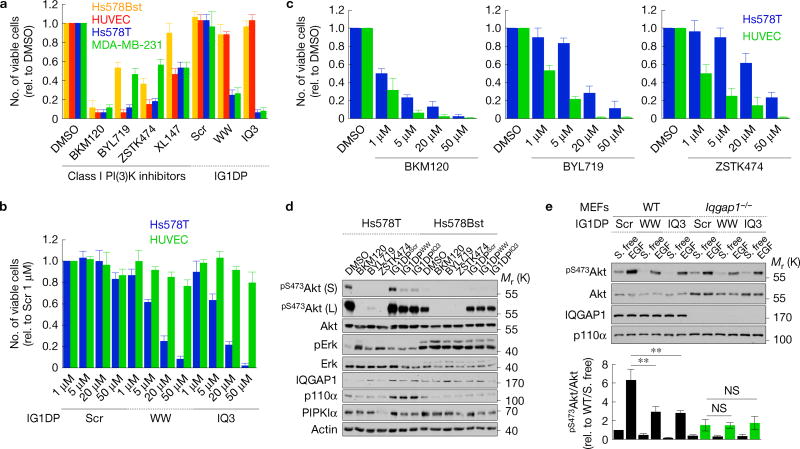Figure 7.
Inhibition of IQGAP1-mediated PtdIns(3,4,5)P3 synthesis is a mechanism for targeted cancer therapy. (a) Viability after IG1DP or PI(3)K inhibitor treatment in Hs578Bst, HUVEC, Hs578T (20 µM) and MDA-MB-231 cells (30 µM), mean ± s.d. of n = 3 independent experiments. (b,c) Viability of Hs578T and HUVEC cells after 1–50 µM IG1DP or PI(3)K inhibitor treatment, mean ± s.d. of n=3 independent experiments. (d) Immunoblots after treating with dimethylsulfoxide (DMSO; 5 µM), BKM120 (1 µM), BYL719 (5 µM), ZSTK474 (5 µM) or IG1DPs (20 µM) in Hs578T and Hs578Bst cells, representative of n = 3 independent experiments. (e) WT or Iqgap1−/− MEFs treated with 40 µM of the indicated peptides were stimulated with 20 ng ml−1 EGF for 15 min. Cell lysates were analysed by immunoblotting with the indicated antibodies (top). pS473Akt immunoblots were quantified and the graph is shown as mean ± s.d. of n=3 independent experiments (bottom). P = 0.030, 0.021. Paired Student’s t-tests were used for statistical analysis (*, P < 0.05; **, P < 0.01; NS, not significant). Source data for a–c,e can be found in Supplementary Table 1. Unprocessed original scans of blots are shown in Supplementary Fig. 7.

